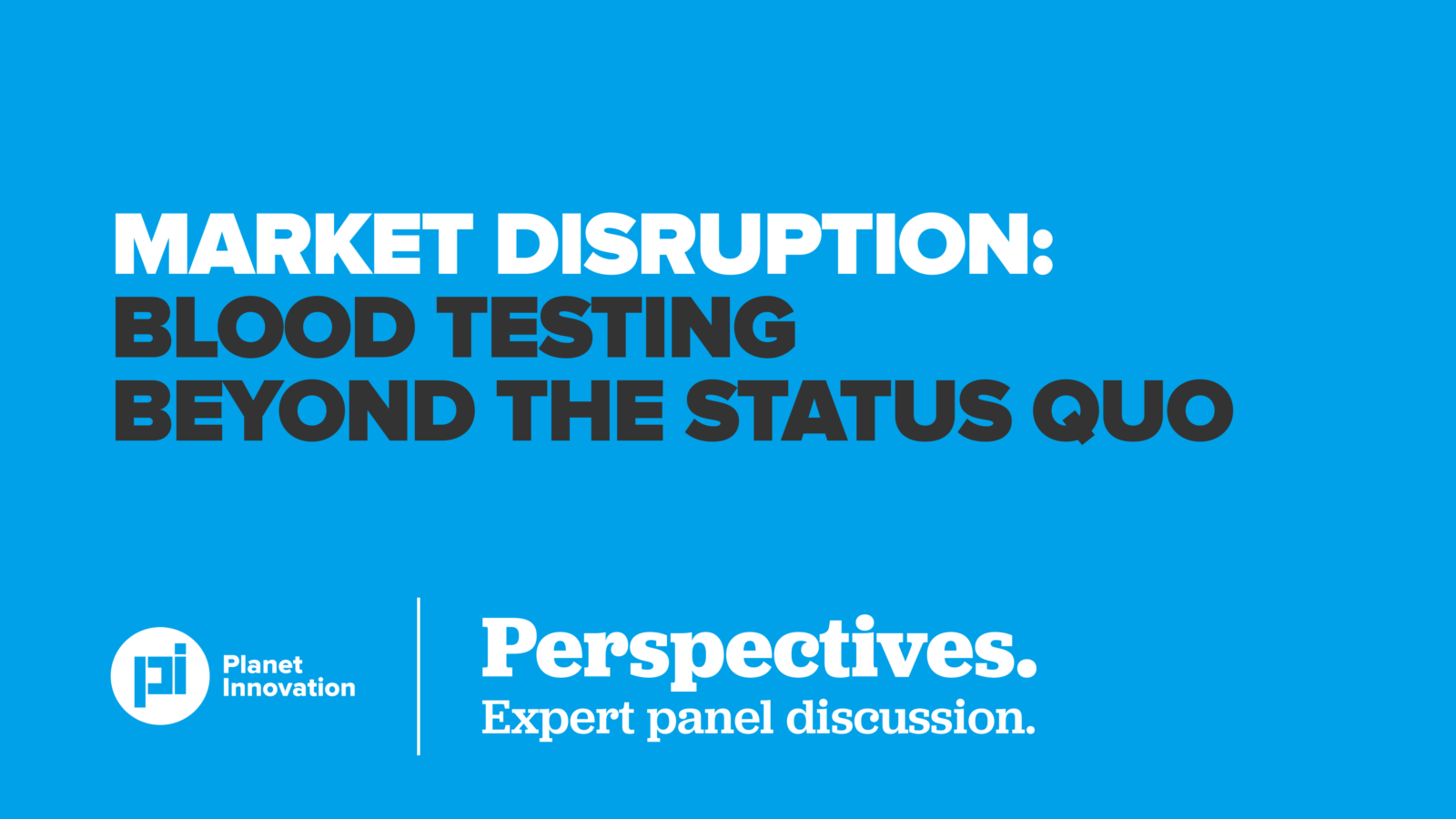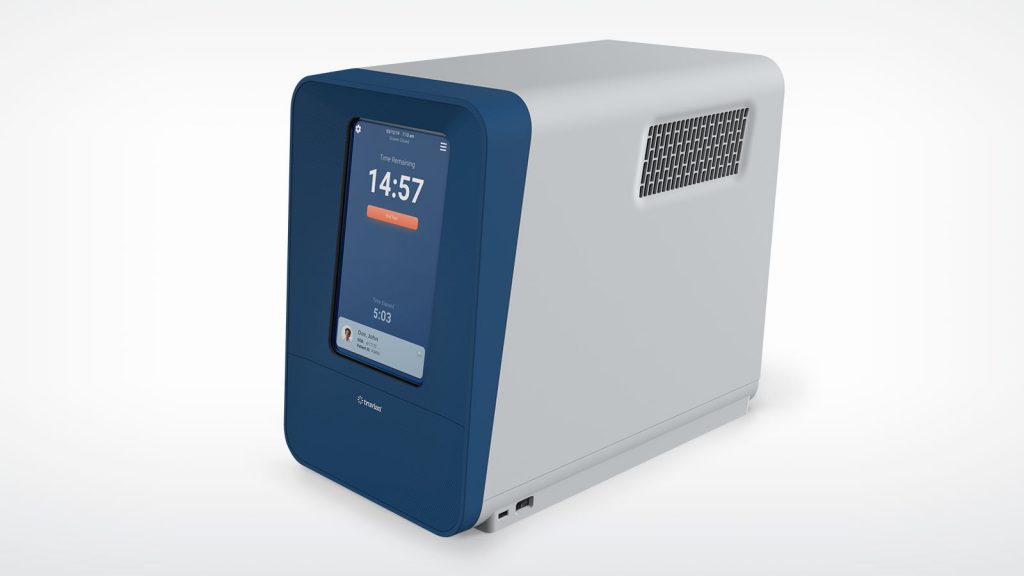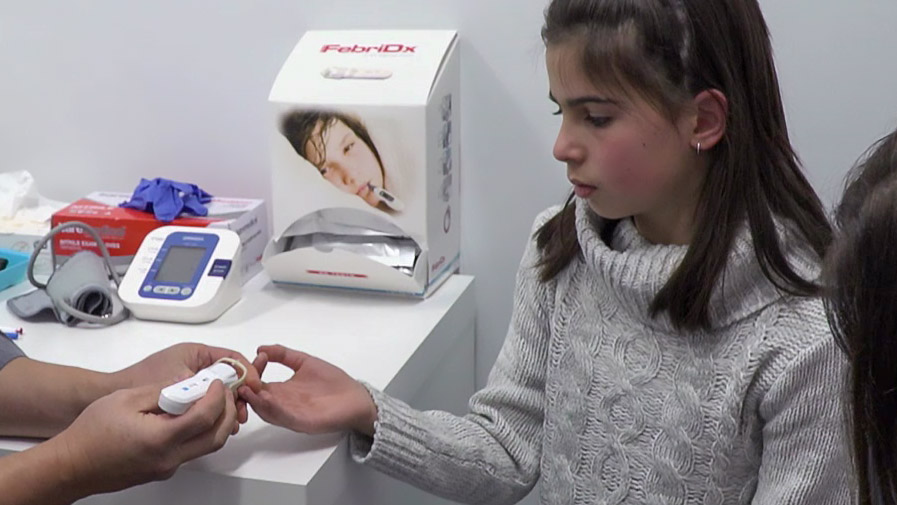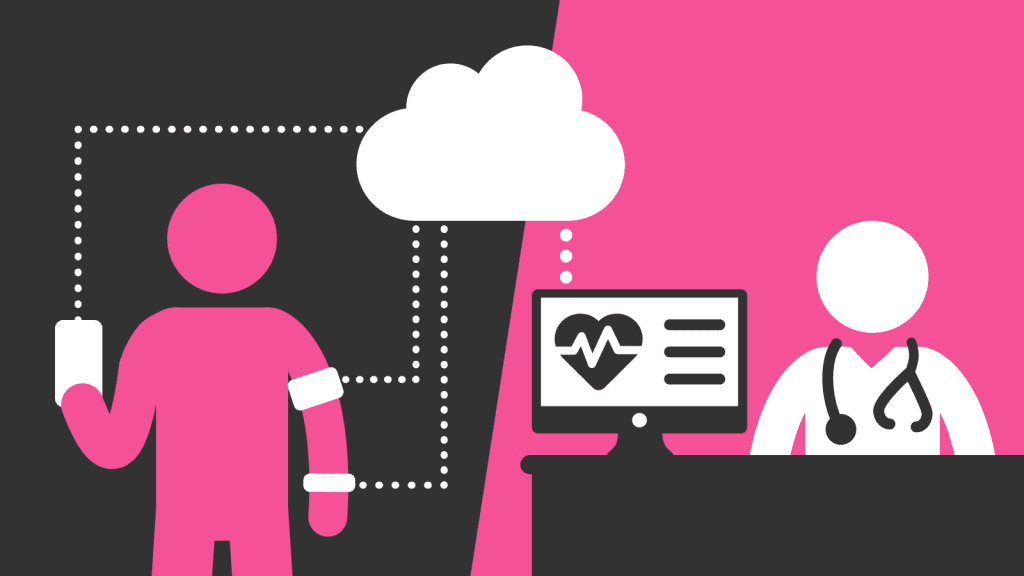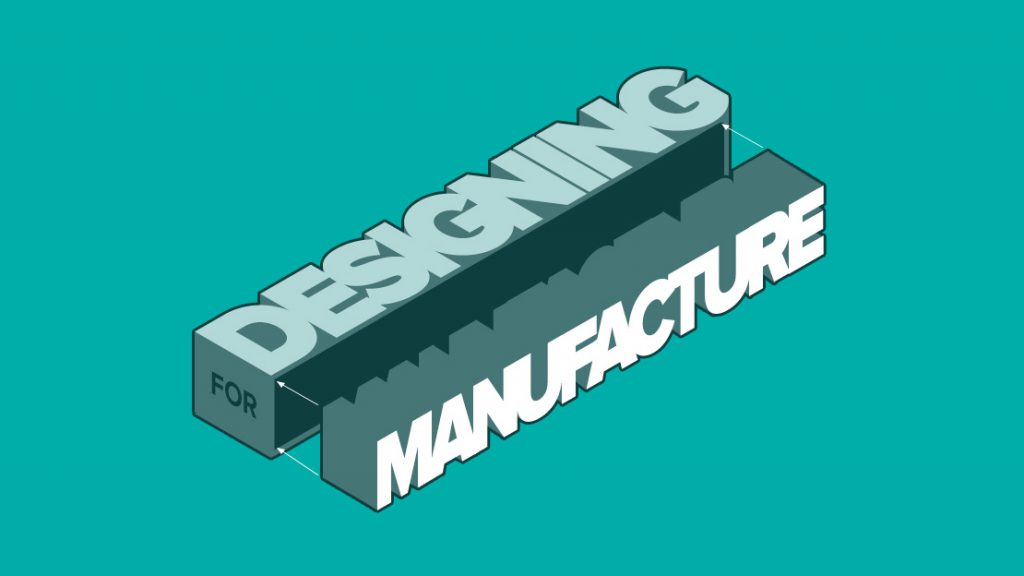
Traditional lab testing has long given physicians and patients powerful insights into their health. But while lab tests continue to be an integral part of healthcare, there is a growing need to give consumers greater ownership and responsibility for shaping their health-related decisions. Real-time point-of-care blood testing has the potential to fulfil this need by providing consumers with accurate and affordable health data in a matter of minutes.
To get a deeper understanding of the potential impact of point-of-care blood testing, PI put together an expert panel including Truvian President and CEO Jeff Hawkins; Blue Ox Healthcare Partners Managing Partner and CEO Dr. Charles Kennedy; University of Chicago Professor of Pathology and Medical Director of Clinical Chemistry Dr. Jerry Yeo; and PI co-CEO and Lumos Diagnostics Executive Chair Sam Lanyon.
Watch the full discussion
Read the transcript
Anthony White:
Well, thank you. Last year, I was able to host Planet Innovation’s first money and markets workshop, and I’m thrilled to be back this year hosting our second. This year’s workshop is Market disruption: blood testing beyond the status quo. The session overview is as follows. Traditional lab testing has long given physicians and patients powerful insights. While lab tests continue to be an integral part of healthcare, the need exists to evolve the current experience, so consumers can take ownership and responsibility for shaping their health-related decisions. This discussion will look at the importance of real-time point-of-care blood testing, and the impact lab accurate blood results in minutes for a comprehensive suite of health tests could have. The panel of experts will discuss how others have tried and failed to deliver on the promise of truly disruptive rapid blood testing, and why this time is different.
I’m the moderator for the discussion. My name is Anthony White, and I’m joined by four panel members; Jeff Hawkins, Sam Lanyon, Dr. Charles Kennedy, and Dr. Jerry Yeo, who I will introduce in a moment. I’m President of Planet Innovation’s North American business and a member of the executive management team. For those of you unfamiliar with Planet Innovation, Planet Innovation is a healthtech innovation and commercialization company. Planet Innovation exists to create breakthrough products and commercially successful businesses that transform industries and have a positive impact on the world. Our 300 plus team includes experts in research, design, engineering, manufacturing, funding, and marketing of new products and new businesses in diagnostics, life sciences, and healthcare industries. I would now like to introduce our panel members.
I’m delighted to introduce our first panel member Jeff Hawkins. Jeff is president and Chief Executive Officer of Truvian. Truvian is disrupting the blood testing industry by developing an automated bench top diagnostic system to provide lab accurate results in 20 minutes for a comprehensive suite of health tests. Truvian’s proprietary approach for which they are seeking FDA clearance is intended to fulfil the promise of delivering accessible and affordable blood testing from one small blood sample in minutes in a retail setting or private clinic. Prior to Truvian, Jeff held executive and management roles at Illumina, GenMark diagnostics, Hologic, and Abbott. Thank you, Jeff, for joining us.
Jeff Hawkins:
Thanks, Anthony. And thanks Planet Innovation for putting on this symposium.
Anthony White:
I’m now delighted to also introduce Sam Lanyon. Sam is co-founder and Co-CEO of Planet Innovation, as well as Executive Chair of Lumos Diagnostics. Lumos provides a unique offering to its partners by having a full range of expertise in-house to deliver complete commercial ready point-of-care solutions. Lumos’s goal is to enable point-of-care testing to be more accessible, facilitating the migration of diagnostic testing out of laboratories directly to where it’s needed. Thank you, Sam.
Sam Lanyon:
Okay, Anthony. Thank you, fellow members.
Anthony White:
I’m delighted to introduce Dr. Charles Kennedy. Dr. Kennedy is Managing Partner and Chief Executive of Blue Ox Healthcare Partners. Blue Ox Healthcare Partners is a private equity firm invest in growth capital in commercial stage healthcare companies. Since 2017, Blue Ox Healthcare Partners has led over 100 million of equity investments, including nearly 40 million invested directly by Blue Ox. Prior to Blue Ox Healthcare Partners, Dr. Kennedy held executive roles at Healthagen, Aetna, Anthem’s health core subsidiary, WellPoint, CareAssured, and Blue Shield of California. Prior to those executive roles, Dr. Kennedy was a practicing physician. Thank you, Dr. Kennedy for your time today.
Dr. Charles Kennedy:
Anthony, thanks for having me. Pleasure to be here.
Anthony White:
Thank you. I’m now delighted to introduce Dr. Jerry Yeo. Dr. Yeo is a professor of Pathology and Medical Director of Clinical chemistry, University of Chicago. Dr. Yeo is an academic, clinical chemist with over 30 years of experience and is board certified in clinical chemistry and toxicology chemistry by the American Board of clinical chemistry. Prior to the University of Chicago, Dr. Yeo held positions at Dartmouth–Hitchcock Medical Center, Beth Israel Hospital, and Harvard Medical School. Dr. Yeo has also held various chair positions with the AACC. Dr. Yeo, it is a pleasure. And thank you for joining us.
Dr. Jerry Yeo:
Thank you, Anthony, for inviting me to join in this panel discussion. I look forward to it.
Anthony White:
Thank you, Dr. Yeo. Well, thank you all. I’m looking forward to today’s discussion. The format is really one where I’ll ask a series of questions to the panel, and have an opportunity for each of you to provide a response and perhaps some general Q&A before we move on to the next question. We have three to four questions that we’ll be asking today. And let’s get the discussion started.
Our first question is, what is the importance of real time blood testing? Jeff, could I ask you to start us off here?
Jeff Hawkins:
Sure. Thanks a lot for the question. I look at it maybe in two pieces. When we started the company, when we were thinking about the strategy of the company, we first started and said, why did consumers want it, and when we learned a lot about convenience, and the desire to be able to get it closer to their home, closer to their place of work, and sort of the preference for more flexibility and time, right? So working professionals, the ability to go off hours, the ability to maybe go into another setting, like a retail clinic, where they can go on a weekend.
These sort of access points, making it more available to them. When we would ask the healthcare professionals in these distributed settings, whether that’d be a retail clinic or a corporate clinic, we heard a lot about the desire to have the diagnostic results available right then, while they’re having that consultation with the patient. So rather than send somebody home and call them back several days later with test results, they could have that conversation at one time and wrap up that healthcare interaction. And if you think about those two things, the other thing is, it enables, and I’m sure one of my panel members might dig into the deeper, is really the cost benefit of potentially doing that meaning multiple tubes of blood now down to a single sample, not having to send samples overnight into laboratories. So there’s also a potential cost component to that, that we heard when we were in the market.
Anthony White:
Excellent. Thank you, Jeff. Sam.
Sam Lanyon:
Thanks, Anthony. And Thanks, Jeff, for that response too. I guess one of the things that I’ll mention are referred to quite a bit is going to be the pandemic, obviously, we’re all living through it right now. But Lumos was in the process of launching its product into Europe when the pandemic hit. So, if you don’t mind, I’m going to talk a little bit about that, because it’s been quite a disruptive event, both from a business perspective, but also obviously, it’s a global crisis. And I think the importance of real time testing is really being driven home with the pandemic, because the health system has been clearly exposed due to the sheer number of high risk patients that have been presenting and the need to manage those and to look after those patients as well.
But that said, you talk specifically, Anthony, about blood testing as opposed to just generic, sort of real time testing. And so for my mind, that then goes towards sort of the host immune tests that are looking at acute illnesses, which we happen to have one of those tests. Our lived experience during the pandemic was that, that our tests, which is the FebriDx test showed an impact when it was pretty quickly adopted by mostly departments out of Europe and the UK. And what they were looking to do was they wanting to really quickly triage suspected COVID-19 patients. The clinicians use this host immune tests to do some really quick triage and bacterial infections need to be treated immediately, viral infections needed to have the patient isolated so that they know that they’re less risk to others while they’re going through confirmatory testing. And then actually, there was a lot of worry, well, that were turning up at the emergency rooms and are still today. And that shouldn’t be there, because that actually creates a huge amount of risk. Now, for the purposes of this discussion, though, it’s important to know how we actually managed to get that implemented quite quickly considering how the pandemic came on us quite quickly as well. And one of the things that was really important for us to recognize is that by being a point-of-care test, being really easy to implement, and actually working alongside and augmenting the existing clinical protocols, it was actually quite reasonably seamless to actually get it in place, and actually providing new information real time that actually made the clinical outcomes better. And I think that was the success and the impact that that test in particular had in the early days of the pandemic.
Anthony White:
Okay, thanks, Sam. Yeah, I think it’s that as Jeff said, the convenience preference being real time is obviously critical there as well. So thank you. Charles.
Dr. Charles Kennedy:
Well, Sam mentioned one crisis we’re facing, which is COVID. But we also had another crisis we have been facing and continue to face, which is the affordability of health care to American citizens. And regardless of whether you think about affordability from the perspective of access, or simply how much things cost, the federal government, private payers, all of the folks involved with paying providers of care have settled on a common strategy. And that common strategy is known as value based contracting or value based care. And what it basically means is, instead of paying fee for service, a provider creates a service and receives a fee, which is inherently inflationary, both in terms of the volume of services provided, but also in terms of their appropriateness and whether they are being done in the most efficient way possible.
What value based care seeks to do is to transition us away from a fee for service environment, and into one focused on value, so that the providers who are most effective at creating compelling results for their patients are actually the ones who receive the most profit, rather than those who might provide simply a higher volume of services or a greater complexity of services. So that’s the context within which real time blood testing finds itself. I think it’s actually going to be a fairly important tool, actually very important tool, because the changing economics and how we pay providers is going to force them to look at each physician-patient interaction, or each patient accessing care, such as blood tests, not as something that is simply something that’s done, but as a valuable asset to be managed efficiently and effectively.
And so as Jeff was speaking about earlier, the ability to go in, have your blood tests done, get the results back immediately, and then meet the patient’s need all at one single visit rather than stretching those visits out across multiple visits, I think is going to be an increasingly important capability for hospitals, for physicians, physician groups, nationally as we move more and more into this value based world. So I do think it’s going to play a pretty fundamental part in enabling the providers of care to meet the new incentives that are being created.
Anthony White:
Thank you, Dr. Kennedy. And I would agree, I think perspective of value based care is an important one, we’ll come back to that in a moment as well. Thank you. Dr. Yeo, it’d be great to hear your insights from a clinical perspective as well. And you’re just on mute. If you could…
Dr. Jerry Yeo:
Okay, I’m going to assume that real time blood testing can be done accurately. Therefore fast, cheap and good. Because most of the time in laboratory testing, you tend to get two out of the three. So for real time blood testing to make its impact, it definitely got to be really good, really fast, and hopefully not too expensive or affordable. So, working in a clinical laboratory in a major teaching hospital or major teaching hospital, I see that it will be most beneficial for situation where the result would direct acute management decision. For example, if someone is being seen in the emergency department or being seen in the radiology suite, who might need further workup or treatment, that could be contraindicated. If a patient is pregnant, you want to have a rapid pregnancy test to inform the physician whether a patient is pregnant or not, therefore they can then manage the treatment. For example, if the patient is pregnant, they would not give a certain kind of guide that could be contraindicated, or certain types of medication.
For some very invasive procedures, it would really help you who’ve got real time testing to help them localize. For example, you try to localize at normal, the adrenal glands, if they have real time testing, for example, for cortisol, they could easily figure out as they are trying to place the carve in the right location, whether they’re in the right location, instead of currently what’s been done is to sample it and hope that they are in the right spot, and then maybe later find out after the procedure that they are in the wrong spot, therefore having to recall back the patient for another invasive procedure. So in this case, these are some of the examples of where the direct benefit of real time testing would be provided.
Anthony White:
Thank you Dr. Yeo. And I agree, I think it’s that a test needs to be fast, it needs to be affordable. But it also needs to be extremely high quality, as you mentioned, as well, I think that’s critical. Jeff, would you like to maybe summarize the discussion just here or add a few extra comments?
Jeff Hawkins:
I mean, I think we’ll build on this in the next couple of questions, Anthony. But Dr. Yeo raises a great point, which is, you can’t just do it fast and cheaply, and then trade off for the quality of the result. Because if you want to deliver on the outcome that Dr. Kennedy is raising about improved care, quality underpins that improved care. So I think that’s a theme that’s likely to play out in the next few questions here as we work through them.
Anthony White:
Yeah, I tend to agree. Thanks, Jeff. And thank you, panel members. So let’s jump into the to the next question, which is, will point-of-care blood testing have the level of impact everyone is predicting? And in what ways? Again, Jeff, let’s start with you.
Jeff Hawkins:
I think if we just build off of where Dr. Yeo ended, today, a lot of the deficiencies in point-of-care testing has been that difficult trade off, how do you have it fast? How do you have it high quality? And how do you have it lower cost? And I think you take that challenge, and then you have to add over the top of it, and how do you have enough breadth of coverage? I think, to think that these highly distributed clinics are going to have three, four, or five, six different platforms to do smatterings a different test, it’s just also not sort of practical, right? There’s an inertia to change that that exists, no matter if we’re talking diagnostics or just anything you might purchase in your personal life, there’s always an inertia that change and just do what you’ve been doing. So I think, with the right platform, I think these advanced point-of-care platforms will have an impact, they will come to market with the breadth necessary, they will come to market with quality in mind.
I know at Truvian, we think about quality first. And that’s just sort of core to what we’re doing. But with that said, I think there’s people who try to say, “Oh, well, these advanced point-of-care platforms are going to somehow spell the end of other machines or the clinical lab.” And that’s just not going to be the case, there’s so many things that have to be done in the diagnostic world, so many parameters that get looked at advanced technologies coming to market. Today, you see it in genomics, you’re going to see in proteomics in the future, there’s always going to be a role for both. And I think it would be naive to think that a point-of-care platform can really replace the entire lab. I think it will help with routine testing and allow our colleagues like Dr. Yeo to be doing those advanced tests, those tests that require a specialist to be nearby, and continue to raise the bar of diagnostics moving forward.
Anthony White:
Thank you, Jeff. Sam, do you want to jump in?
Sam Lanyon:
Yeah, so obviously agree with all panels’ points in terms of speed and quality and convenience, and what’s limited point-of-care penetration today. It’s never going to be a silver bullet for every illness and every setting. I do think the US is well ahead of a lot of countries around the world. And the inertia that Jeff talked about earlier, in some countries, it’s actually really significant. And it’s not just the inertia of just a new test and a new paradigm. It’s structural inertia as well, that’s actually stopping the adoption of some of these technologies. And I think when you got inertia, sometimes you need a big shock or a big jolt to get people to think about what if scenarios, and obviously we’re obviously once again, we’re gearing up a pandemic again. But that has been quite a shock not just obviously in the US, but elsewhere in the world. And I think even though we don’t know what it looks like post pandemic, we do know that a lot of things have changed and changed reasonably quickly. I’m reflecting on the rest of world here, guys, because obviously, I haven’t had a chance to travel to the US recently, unfortunately. But seeing the acceleration of adoption of some point-of-care technologies that I had struggled to get a foothold, but have managed to do that now because of limitations on supply and also needing to be near a patient in terms of some of the viral respiratory panels and things like that. Regulatory authorities have simplified clearance processes and open to considering new things such as out of home sampling and out of home testing, which, once again, was relatively unheard of. I know that this is happening in a lot of countries worldwide, there’s a whole bunch of new modalities that are being piloted, such as testing before you get on a plane or testing before you go see a loved one in aged care.
And so all this stuff is happening reasonably rapidly, and it’s been pretty disruptive, and as point-of-care companies like Truvian or like us have to consider what does the new landscape look like. And have to revisit business plans, and in some cases, like in Lumos, we’ve actually had to revisit our business plan twice in six months, just because the market development phase that we’re going through is seemingly changed a lot quicker than what we expected. So the question really then becomes how sticky is some of these changes going to be. I think you can look at some precedents around Asia and how it responded to SARS and bird flu and stuff like that, and you think that governments and health systems do have a long memory, and they do sort of plan for the future, given that they know how bad that looks like. And so I think once you actually married that with consumers making some decisions I’ve just been referring to and wanting convenience, there’s some really interesting things, not just from a clinical outcomes perspective, but from a health economics and consumer preferences that are going to start to make the landscape be very different for point-of-care companies as we introduce our products to market.
Anthony White:
Yeah. Thanks, Sam. It’d be good Dr. Kennedy, to get your perspective on the health economics side there as well.
Dr. Charles Kennedy:
Sure. I’d like to follow up with my previous point about value based incentives. Because some things when we begin to pay on value, like a surgical procedure has a specific beginning, a specific end. That can be more straightforward to pay on a value basis. You can look at things like complication rates and other things to get a handle on quality, and cost is pretty easy or pretty straightforward to aggregate the cost around an episode of care. That’s pretty easy. Unfortunately, or fortunately, in some ways, that’s not where we spend most of our money, most of our money as a country is spent on chronic disease. Estimates are that 70 to 80% of health care dollars can in some way be tied to an underlying chronic disease. And the problem with that is that chronic disease will increasingly create a need for accountability. So what you’re going to see are providers who actually will take accountability for the overall health and wellness of a particular set of patients. And that’s going to force them to think about, “How can I make it more convenient for a patient to get access to the right kinds of care so that their diabetes doesn’t move in the direction of greater complications?” And that’s going to take us I think, more in the direction to a retail setting. And so I think the notion of providing health care in a seamless way to where the consumers, where the patients are actually living their lives anyway, will be a powerful boost for the retailization of these point-of-care of blood testing capabilities, and I think will be a powerful push in their adoption.
The other thing I’d point to, is the changing ways that the individual consumer pays for health care. When I was early in my career, the average deductible was 100 bucks, a couple 100 bucks. Today, the average deductible for an American is over $1500. And when you think about an American, the average American not being able to afford an unplanned 400 or $500 expense, that $1500 expense, that is their deductible becomes a very powerful thing that they’re going to have to manage through as individuals, as families. And that’s going to make them look more like what we would say, a B2C kind of environment rather than a B2B kind of environment, right? After your housing, your car, it’s your health care deductible. And so that dynamic, I think, is going to drive additional retailization, if I can get the information I need from a point-of-care blood testing capability in a retail setting, and I can get it for less, and I can get it quicker, I think you’re going to see consumers kind of vote with their feet, so to speak, and go to those kinds of providers preferentially. So I think those two dynamics, the consumer on the demand side saying I need convenience, and I need lower costs, and I’m empowered to do something about it, as well as the provider now being accountable for those costs and having to innovate, to bring down the out of pocket expense for those consumers. To me, it’s almost the perfect storm for these point-of-care blood testing capabilities.
Anthony White:
Yeah, that’s interesting. And again, and probably picks up on what Jeff was mentioning, in terms of that breadth of coverage that’s needed there as well. As a consumer, you’ll want to be able to go to these settings and be able to get the tests that you need there as well. So thank you for that. Dr. Yeo, it’d be great to have your input into this question as well.
Dr. Jerry Yeo:
Yeah, I’d like to pick up on the comment made by my colleague, Charles, over there. But before that, I’d like to clarify that we use the term point-of-care as a generic term. But in actual fact, it covers both testing done at the patient bedside within the hospital setting or clinic setting, as well as including those testing mentioned, done in retail setting like a retail pharmacy setting like Walgreens or CVS, mini clinic, or something like that. So I do agree that if for chronic patients, they have chronic disease, they are under monitoring, constant monitoring, to make sure that their health under surveillance and constantly under surveillance by the physician, it will be great if those testing that contributes to the surveillance can be done in a retail setting, ideally, near the place where a patient lives.
I can tell you, for example, like if a patient who comes to the University of Chicago, if they get transplanted with liver, or heart, or some other organs, they remain for the rest of their life, a patient of our medical center. However, they could be living anywhere from 15 to 50 miles or whatnot, within the suburbs, or outlying area. That makes it very, very impractical for them to come in on some regular basis to get the test done in the hospital. For example, if they need immunosuppress present drug, they need to be monitored critically, just so that they don’t become toxic, or if the drug is not enough, they can start rejecting the organ. So they get the test. Where do they get the test? They get the test, typically near where they live. So if you’ve got a point-of-care reliable device that can provide the immunosuppressive drug monitoring, for example, that is as accurate as one could get in the hospital lab, that will be a game changer. That means they can get the test right there.
And you know how it is, if it is easy, people would be more compliant to go to the place and get the blood drawn and get tested. If it’s like jumping through a gazillion hoops, people give up and they might not want to bother after a few trials. And we-
Anthony White:
Thank you, Dr. Yeo. Yes, thank you. I think it picks up on many of the points that everyone’s just raised around having that breadth of coverage, offering tests in different ways, managing chronic diseases, managing them locally, and in a convenient… they’re more likely to be compliant as well. So I think that’s encouraging. Anything, Sam, you would like to add to that discussion at all?
Sam Lanyon:
Yeah, I think it’s really interesting, I think the way that Charles was talking about, but the switch from B2B to B2C, it becomes a marketing dilemma, right? Because if you start talking about consumers and adopting them driving the adoption of new technologies and paradigms, interesting, I think, from Jeff’s point of view, yes, breadth of coverage means what you’re doing is you’re basically trying to get inside the consumer, where their first step is to go to the retail health clinic or something like that. Whereas from Lumos’ perspective, we’ve got a very specific niche application, is trying to stop people from going to that next step or at least reasonably high proportion, should just be staying home and not necessarily seeking help straightaway.
So for us, it’s a big challenge that that shift from B2B to B2C, and the need to make awareness around whether it be a complete suite of tests or whether it be a very specific niche test. And it’s quite a challenge that we have to get our heads around.
Anthony White:
Yeah. Dr. Kennedy, would you like to mention just a few final remarks on this topic?
Dr. Charles Kennedy:
You know, it’s a really interesting time to be in healthcare innovation, because… I’ve worked for health plans for 20 years, and I can say with great confidence that health plans can literally slice and dice a whole variety of payment methodologies aligned with value based incentives. That’s not the problem. The problem has been how do you create the organizational structures that can accept the responsibility, how do you bring innovations to those organizational structures? Be they retail hospital, whatever the environment is, but just because we change how we pay doesn’t mean we actually create value. You have to actually change the workflows, you have to change the processes, and you have to change the underlying technologies. And so I’m really pleased to see these kinds of point-of-care blood testing technologies beginning to come into the marketplace, because they meet that need.
We’re kind of setting the table as health plans for innovation that offers better value, but health plans don’t know how to deliver that better value. And I think providers are really going to need help, and it’s innovations such as this, that I think will continue to help them walk down the line of a better value. And we all know, the American consumer certainly needs better value for the healthcare toddler at this point. I’m very pleased to be on this panel and hear about these new technologies coming to bear.
Anthony White:
Excellent. Thank you, Dr. Kennedy. So let’s jump into our last question here. Question number three, which is the true market disruption is a rare occurrence. Why? A bit of an opportunity for us to maybe step back and gather a whole bunch of thoughts here. So maybe Jeff, jump in, continue on the conversation there and jump in this third question as well.
Jeff Hawkins:
Yeah, Anthony. Thanks. As someone who’s spent their entire career in the industry, I would say it hasn’t happened often because it’s hard. I think what Dr. Yeo is asking for, is what’s needed, right? It has to be better, faster, cheaper. And if you think about that, those factors equal complexity, technologically equals risk. Risk tends to be resolved over time, and all those things equal money. And at the end of the day, to pull off what companies like Truvian is doing, you have to have investors. And finding investors who have an appetite for risk, have an appetite for the time it can take to pull this off, and have the commitment to the vision to do the disruptive product is a tricky intersection to find. I think it’s easy to convince yourself on the industry side to say, well, I’ll just build a CDC machine, or I’ll just build immunoassay analyzer, but it won’t have the type of impact we’re talking about, right? It’ll have an incremental impact or very minimal, because you’re back on that inertia to change, you won’t overcome that starting inertia.
I think one of the big challenges has just been the company with the vision and the commitment, but with those key investment partners who are willing to support that, for the types of horizons it takes, right? It’s years, and 10s of millions of dollars, not months and millions, right? And I think that’s a challenge that has to be overcome, to really deliver platforms that will have the attributes that Dr. Kennedy and Dr. Yeo are saying, are necessary to have the impact.
Anthony White:
And do you think that with the current pandemic at the moment, that that may accelerate things we see NIH stepping in with RADx programs, these sorts of things? What’s your perspective on that?
Jeff Hawkins:
I think that’s a start. Another view of the pandemic is it’s forcing trends in healthcare to happen faster. And it goes back to the comments around B2B versus B2C. I think telemedicine has been slowly moving along for many years and then now there has been an absolutely rapid acceleration in utilization of telemedicine from people who have long had access to never used it. So I think government grants and government funding is a vehicle but really the market changing and calling upon the demands for these will make it interesting to investors that aren’t the government. If the consumer is controlling this, if healthcare is moving, if point-of-care is becoming important to delivery of care, well, then investors will naturally be interested because there’ll be a market for it. It goes both ways, but the pandemic I think, has definitely pulled forward changes in healthcare by many years.
Anthony White:
Yep. Excellent. Sam, do you want to maybe pick up on this point there as well?
Sam Lanyon:
Yeah, I think you’re just starting off by basically insinuating that we need to find investors that are patient, Jeff. I think that’s the fundamental, right? It’s creating an overnight success from a point-of-care diagnostics companies is hugely expensive and risky. And it means that you tend to see companies that have got big visions that are looking to disrupt very large markets, the ones that attract the right investors and get the right resources in order to pull it off. And I think that’s what Jeff, definitely doing at Truvian. I think when I reflect on our company at Lumos, we’re focusing on a whole range of different markets, and each one of them, they’ve got their own elements that need to be addressed in terms of trying to become an overnight success and disrupt.
I think one of the good things, which absolutely Jeff has just said to is that there has been a change in terms of accelerated markets, as well as investors that are looking to invest. And I’d say that you are probably going to try and reflect outside of the US for the moment, Anthony. Traditionally, we’ve looked at the US and said, “Geez, I’d love to have investors like the US companies have that are backing them.” And it’s great now that the category is saying a lot more interest, and there’s a lot more investors that are looking at it into companies like ours and others in the world that are in the process of getting into market. But I do think that just they’re always going to be the same, right? They’re going to look for companies that have got quality IP, they’ve got a beachhead, a commercial beachhead, they’ve piloted and they’ve shown you a real clinical impact. And they’re showing probably the most important thing is it’s not just about COVID. I mean, the amount of times I’ve been asked, or even disregarding what’s happening right now that we’re all dealing with, and actually focusing on what does the future look like in three to five years time, you need to convince me that I’m going to give you my dollars to create a really important business that’s going to disrupt globally. And so, whilst investors savvy, they’re not necessarily patient, and you’ve got to find the right ones to support you and your company.
Anthony White:
Thanks, Sam. Dr. Kennedy, it’d be great to hear your perspective on why true market disruption is such a rare occurrence.
Dr. Charles Kennedy:
Well, healthcare is… we always say healthcare is different, and it really is. I think one of the reasons market disruption is uncommon is because we actually want it to be uncommon. When I look at market disruption from a scientific perspective, when physicians are trained, I remember back in my training, I was scolded by some of the physicians who were training me to say, “Never read beyond what the research actually tells you. Because many, many times, even though a logical trend might be A leads to B leads to C, but you’ve only proven a leads to B, don’t make that leap to C, because you haven’t proven it yet.” So there’s an inherent bias toward innovation being incremental and slow in nature that comes from the science, and that really is appropriate, I think. But when you look at the finance side, it’s literally the polar opposite, right?
The financial markets are all about, “Oh, I see A, I see B, C is likely and I’m willing to make a bet on C.” That tension has never really been constructively worked out in the healthcare industry, and it tends to be in many ways dysfunctional. And so we end up with an environment where bringing innovations to market takes longer than it probably should, results in products that are more expensive than they probably should be. I’m cautiously optimistic that what’s different this time about market disruption is that you actually have the federal government, private payers, all saying it’s all about value. That really hasn’t happened very much in our past. And so that gives me a sense of optimism.
And then as I look at the Biden administration coming into power, of course, the Affordable Care Act is going to be front and center in what they support. And we talk a lot about what it did for access, but we tend to under emphasize that it created CMMI, the Center for Medicare and Medicaid Innovation, and it was all about investigating this intersection of how we pay for things versus how we innovate and reward people for valuable innovations. My hope is that he’s going to double down on CMMI and give it a larger charter to help us bring these innovations to market more quickly, more efficiently, and just to safely.
Anthony White:
Excellent. Thank you, Dr. Kennedy. That was very enlightening. And Dr. Yeo, it’d be great if you could pick up on Dr. Kennedy’s regulatory remarks and how you see the FDA’s role in this as well.
Dr. Jerry Yeo:
Yeah, I think I would start by saying that novel and disruptive technology is rare, because science is hard. And even if you had important scientific discovery, it’s still a long drawn complicated process, from discovery to testing to final approval and marketing. They just need to go to the complex process. And I would say if something is really novel and disruptive, I would believe that it needs to clear a high bar through FDA who obviously needs to approve the technology, and as well as convincing the clinical community to accept that technology, right? So it doesn’t help that we recently have this bad example of Theranos where something was promised to be truly disruptive sounded really good, but then turns out to be a fake. That sort of setback, the disruptive technology in the sense that people are now more skeptical, it takes a little bit more convincing. But regardless, we want disruptive technology, obviously. But we want it in a way that it can be delivered safe and delivered to be effective, and it’d be just take a little bit more time to get it through. So be it.
I think the fact that the FDA is trying to promote innovation as seen by this recent COVID pandemic and all this new technology coming up. And even most recently, you see the point-of-care home testing PCR, which I thought it was rather revolutionary to see it finally being approved to be done at home, shows that the FDA is very willing to look at disruptive technology and promote it to a certain extent as long as the technology is sound and passes muster. But I think in the end, anything disruptive needs to be supported by publication, need to be vetted independently by scientists like myself and other scientists, clinical scientists, before it is finally to be accepted. Because if you try to take shortcut prematurely, you can have hurt a lot of people, if it turns out to be released prematurely.
Anthony White:
Yeah, I completely agree with you. I’m sure all the panel members do, in that independent peer reviewed studies are always necessary, and I think viable. Maybe, Jeff, a couple of closing comments from you with regards to this last question as well. That’d be great.
Jeff Hawkins:
Yeah, I mean, I think what Dr. Yeo was just raising there is, it’s just another aspect of why innovation is hard, is it could be done right. And at the end of the day, it has to be done right. There are a lot of things beyond just making the technology work. There’s proving it in the validation studies. There’s the regulatory processes, and while the FDA has shown innovation, there still are bars that need to be met to be safe. And beyond that, I think Dr. Yeo raises another component of it, which is the independence and the assessment of technologies by the clinical lab community, that is that required for a company like Truvian to launch by the line of the law? No, but is it a critical aspect of what we do? Absolutely.
The FDA stamping is great, and we’ll be very happy when we get to that day. But it’s equally as important that the experts in the field look at this independently and validate it, and publish on its results. Here in the United States, frankly, abroad, we would expect clinical lab scientists in Europe and other places to do that as well. I think it’s a continuous process, right? It doesn’t end with FDA approval, or CE-IVD marking in Europe, right? That is sort of the beginning of the race, not the end of the race. And that goes back to the entire question, which is why is it so hard? Well, it’s a marathon, not a sprint.
Anthony White:
Excellent. Thank you, Jeff. And thank you all the panel members as well for the enlightening session today, thoroughly enjoyed that. Hopefully next year, we can all get together and do this live at an AACC event, that would be wonderful. Hopefully, some of the technologies we’ve discussed during this session will help even enable that. So thank you again. Yep, thank you very much.
Sam Lanyon:
Thank you, Anthony.
Jeff Hawkins:
Thanks for having us.
Anthony White:
Thank you.

